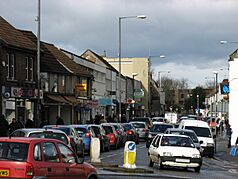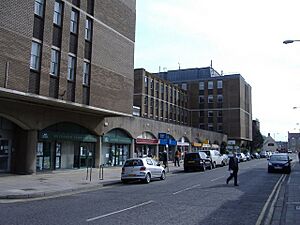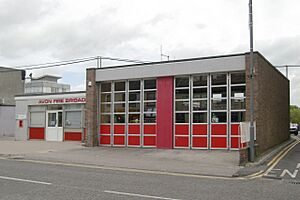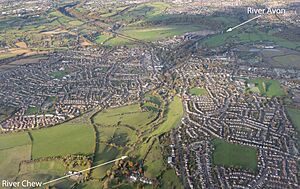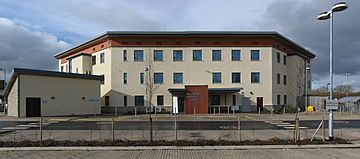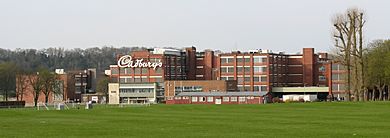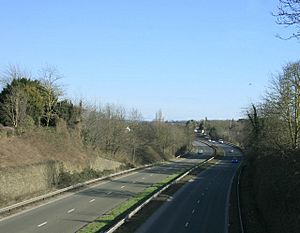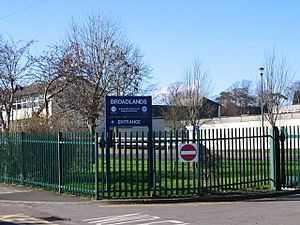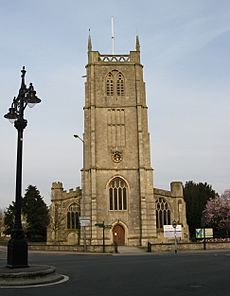Keynsham facts for kids
Quick facts for kids Keynsham |
|
|---|---|
|
From the top, High street, Riverside Centre, Church of St John the Baptist, Marketplace and the Clocktower
|
|
| Population | 19,603 (2021 census) |
| OS grid reference | ST654684 |
| Civil parish |
|
| Unitary authority | |
| Ceremonial county | |
| Region | |
| Country | England |
| Sovereign state | United Kingdom |
| Post town | BRISTOL |
| Postcode district | BS31 |
| Dialling code | 0117 |
| Police | Avon and Somerset |
| Fire | Avon |
| Ambulance | Great Western |
| EU Parliament | South West England |
| UK Parliament |
|
Keynsham (pronounced KAYN-shəm) is a town in Somerset, England. It's located between the cities of Bristol and Bath. In 2021, about 19,603 people lived there. The town's name, Cainesham, might mean "the home of Saint Keyne".
People have lived in Keynsham since ancient times. It might even be where a Roman settlement called Trajectus once stood. Archeologists have found the remains of two Roman villas and many other Roman buildings. Keynsham grew into a market town after Keynsham Abbey was built around 1170.
The town sits where the River Chew meets the River Avon. It used to flood often until Chew Valley Lake was created and river levels were controlled at Keynsham Lock in 1727. However, a big flood in 1968 still covered much of the town. For many years, Keynsham was famous for the Cadbury's chocolate factory, Somerdale, which opened in 1935.
Keynsham has a lovely place called Memorial Park, where the yearly town festival is held. It also has nature reserves. The town has its own Keynsham railway station and is close to the A4 road. You'll find schools, churches, sports clubs, and cultural places here.
Contents
History of Keynsham
Ancient Roman Life
People have lived in Keynsham since prehistoric times. During the Roman period, Keynsham might have been a Roman settlement called Trajectus. This Latin word means "bridgehead." Experts believe a Roman crossing point over the River Avon was nearby. Many Roman ruins found in Keynsham suggest it was this lost settlement.
In 1877, workers building the Durley Hill Cemetery found a large Roman villa. It had over 30 rooms! Most of this villa is now under the cemetery and a road. Later, in 1922, more of the villa was dug up, revealing 17 rooms and 10 beautiful mosaic floors.
Another smaller Roman villa was found when Fry's Somerdale Chocolate Factory was being built. Two stone coffins were discovered there, holding the remains of a man and a woman. These finds, including the mosaics from Durley Hill, were kept in a museum at the factory for many years. In 2012, more Roman buildings were found under Keynsham Hams, suggesting a whole Roman road and more structures.
Medieval Times in Keynsham
Legend says that Saint Keyne, a princess, lived by the River Avon in the 5th century. She supposedly turned snakes into stone, which people believed explained the ammonite fossils found in the area. However, there's no real proof that people worshipped her in Keynsham.
Some clues suggest an Anglo-Saxon village existed in Keynsham's High Street area. A church, called a Minster church, might have been there in the 9th century. The first written mention of Keynsham is around 980. It was called Cægineshamme, which means 'Cæga's Hamm' in Old English. The town is also in the Domesday Book of 1086 as "Cainesham." This makes some people think the name comes from "Ceagin (Caega)," not Saint Keyne.
Around 1170, Keynsham Abbey was built by a group of monks called canon regulars. It seems the abbey was built over the old Saxon church. Keynsham then grew into a busy market town. The abbey owned the area known as the Keynsham Hundred. The abbey lasted until 1539, when it was closed down. A house was later built on the site. The abbey ruins are now a Grade I listed building, meaning they are very important historically.
Keynsham After World War II
Keynsham became well-known in the late 1950s and early 1960s. This was thanks to Horace Batchelor's betting system advertisements on Radio Luxembourg. To get his system, listeners had to write to his Keynsham post office box. Batchelor would always spell out "Keynsham – spelt K-E-Y-N-S-H-A-M – Keynsham, Bristol." He did this because the correct pronunciation, "Cane-sham," doesn't sound like its spelling.
Since the 1950s, many people who work in Bristol and Bath have chosen to live in Keynsham. The High Street shopping area was updated, and a Town Hall, Library, and Clock Tower were built in the mid-1960s.
Keynsham used to flood often before Chew Valley Lake and river controls were put in place at Keynsham Lock. The Great Flood of 1968 covered large parts of the town. It destroyed bridges, including the old medieval bridge over the Avon. After this flood, Memorial Park, which was created after World War II, was made even bigger.
Keynsham's Modern Makeover
In the 2010s, Keynsham's town center got a big makeover. The plan was to update the area around the town hall. This project aimed to bring new businesses and jobs to the town, especially after the Cadbury Somerdale Factory closed.
Construction began in 2012, and the new Keynsham Civic Centre opened in late 2014 and early 2015. In the second half of the 2010s, Keynsham also grew quickly, with hundreds of new homes being built.
How Keynsham is Run
Keynsham has a Town Council that helps manage local issues. They decide how much money to collect from local taxes to run the council. They also look at plans for new buildings and work with the police and local groups to keep the town safe and manage traffic.
The Town Council helps maintain local places like the village hall or community centre. They also talk with the bigger district council about roads, drainage, footpaths, public transport, and street cleaning.
Keynsham has several Playing fields and playgrounds, including those in Memorial Park. There are also places for basketball and a BMX track. The council looks after football pitches and a floodlit sports area in Memorial Park. They also support groups that organize music and cultural events. The council cares about protecting nature and old buildings too.
The Town Council started in 1991 and has 15 members who are elected every four years. Keynsham is also connected to Libourne in France, which is its official twin town.
Keynsham is part of the unitary authority of Bath and North East Somerset. This council handles most local government tasks, like planning, roads, housing, environmental health, refuse collection, recycling, parks, and tourism. They also manage education, social services, and libraries. Services like fire, police, and ambulance are shared with other areas.
Keynsham's Location and Nature

Keynsham is located where two rivers meet: the River Chew and the River Avon. The River Chew is a good place for fishing, with fish like chub, roach, and trout. Keynsham Lock on the Avon opened in 1727. Near the lock, there are places for boats to stop and a pub on an island. This island is also where the River Chew flows into the River Avon.
Memorial Park is a large green space in Keynsham, covering about 10.7 hectares (26 acres). It has woodlands and grassy areas along the River Chew. The park remembers those who died in wars and has play areas for kids, a skateboard park, a multi-sport area, and a bowling green. It also has a bandstand and a refreshment stand. The park has won the Green Flag Award several times, which means it's a well-managed green space.
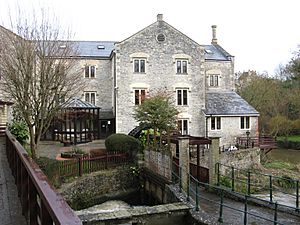
On the edge of Keynsham, you'll find Keynsham Humpy Tumps. This is a special place with many different kinds of plants, especially on its south-facing slope. It's the only place in the Avon area where a plant called upright chickweed grows. Other rare plants are also found here. Near Keynsham and Saltford, a 15-hectare (37-acre) area has been planted with over 19,000 trees. This area, called the Manor Road Community Woodland, is now a Nature Reserve. The Avon Valley Country Park is also nearby.
Keynsham has a temperate climate, which means it's generally milder and wetter than other parts of England. The average temperature is about 10 °C (50 °F). Summers are warm, with temperatures around 21 °C (70 °F) in July and August. Winters are cooler, with January temperatures between 1 °C (34 °F) and 2 °C (36 °F). Keynsham gets about 800–900 mm (31–35 in) of rain each year.
People of Keynsham
In the 2001 census, Keynsham had 15,533 people living in 6,545 homes. Most people described themselves as White. The population of Keynsham has grown steadily over the years. In 1881, there were 2,482 people. By 1961, this number had jumped to 15,152.
Keynsham's Economy
A very important business in Keynsham was the Cadbury's chocolate factory, called Somerdale. The J. S. Fry & Sons company joined with Cadbury in 1919. They moved their factory from Bristol to Keynsham in 1935. Cadbury's, who were Quakers, built the factory on a large green area. It included sports fields and recreational grounds for workers. The Keynsham Cadbury factory made famous chocolates like Fry's Chocolate Cream, the Double Decker, Dairy Milk, and Crunchie.
In 2007, Cadbury announced plans to close the Somerdale factory by 2010, meaning about 500 jobs would be lost. Production was planned to move to other factories. This news was a big blow to the town. People started campaigns to save the factory.
In 2009, an American company called Kraft tried to buy Cadbury. Kraft promised to keep the Somerdale factory open if they bought Cadbury. They succeeded in buying the company. However, just a week later, Kraft announced they would close the factory by 2011, as Cadbury had originally planned. This caused a lot of disappointment.
Culture and Fun in Keynsham
In 1969, the town was featured in the title of the fourth album, Keynsham, by the Bonzo Dog Band. They chose this name to honor Horace Batchelor, who made Keynsham famous by spelling out its name in his radio ads.
The Keynsham Festival started in the late 1990s. It takes place in Memorial Park every July and attracts about 16,000 people. There's also a Victorian evening held in the town each November, which is now called Keynsham Winter Festival. The Keynsham and Saltford local history society was formed in 1965 to research and record the area's history.
Keynsham was also used as an outdoor filming location for a dramatic storyline in the BBC One TV show EastEnders in September 2012. In Northanger Abbey by Jane Austen, characters ride to "within view of the town of Keynsham."
News and Radio in Keynsham
Local TV news for Keynsham comes from BBC Points West and ITV News West Country, both broadcasting from Bristol.
Local radio stations include BBC Radio Bristol (94.9 FM), Heart West (96.3 FM), Greatest Hits Radio Bristol & The South West (107.2 FM), Hits Radio Bristol (106.5 FM), Kiss (97.2 FM), and KTCRfm (105.8 FM), which is a community station broadcasting from the town.
The local newspaper that serves Keynsham is the Bristol Post.
Getting Around Keynsham
Keynsham has its own Keynsham railway station on the main train lines connecting London to Bristol and Bristol to Southampton. The station opened in 1840. The chocolate factory used to have its own rail system connected to the main line, but this was removed in 1980. The station was rebuilt in 1985.
The A4 trunk road used to go right through the town. But in 1964, a bypass was built, so much of the traffic now goes around Keynsham. The bypass connects Saltford to Brislington in Bristol. Keynsham is also about 16 km (10 miles) from the M32 via the Avon Ring Road A4174, which gives quick access to the M4 and M5 motorways.
Keynsham is on the Monarch's Way, a long-distance walking path. This path roughly follows the escape route taken by King Charles II in 1651 after he lost the Battle of Worcester.
In May 2017, the High Street became one-way for traffic going towards Saltford and Bath. Buses and taxis can still use Temple Street from High Street, but other traffic is sent along Ashton Way.
The town has several bus routes. Some connect Bath to Bristol International Airport, others go to Southmead Hospital or Cribbs Causeway. Buses heading towards Bristol, Southmead, and Cribbs Causeway use the stop on Ashton Way. Buses going towards Bath use the stop on the High Street.
Schools in Keynsham
Keynsham has five primary schools: St John's Primary School, Castle Primary School, Chandag Primary School, St Keyna Primary School, and Two Rivers CofE Primary School. Chandag Primary School used to be two separate schools (Infant and Junior) until 2023. St Keyna Primary School was formed in 2007 when Keynsham Primary School and Temple Primary School merged. Two Rivers CofE Primary School opened in 2019.
There are also three secondary schools: Wellsway, Broadlands, and IKB Academy.
Wellsway School is a mixed school for students aged 11 to 18. It was created in 1971 by combining Keynsham Grammar School and Wellsway County Secondary School. Most students come from Keynsham and Saltford. In 2013, Wellsway became an academy and is now part of the Futura Learning Partner group.
Broadlands Academy also became an academy in 2012. It has about 430 students aged 11 to 16.
IKB Academy opened in September 2015. It focuses on Science, Technology, Engineering, and Maths (STEM) subjects. It's for students aged 14 to 19 and offers GCSEs, A Levels, and BTECs. Students also get weekly or fortnightly work placements.
Nearby Bath has two universities: the University of Bath and Bath Spa University.
Churches in Keynsham
The Church of England parish church of St John the Baptist, Keynsham started being built in 1292. It got its current shape after its tower fell during a storm in 1632. The tower was rebuilt using stones from the old abbey church. The church has a pulpit from 1634 and is a Grade II* listed building, meaning it's very important.
Legend says that the famous composer Handel once traded a set of bells for an organ from this church. The church now has eight bells, some made by the Bilbie family.
St John the Baptist is one of five churches in the Church of England Parish of Keynsham. The others are St Michael's in Burnett, St Margaret's in Queen Charlton, the "Mission Church" in Chewton Keynsham, and St Francis' Church on the Park Estate.
Keynsham also has Victoria and Queens Road Methodist churches, St Dunstan's Roman Catholic Church, and an Elim Church. These churches often work together with churches in Saltford under the name "Churches Together in Keynsham and Saltford."
Sports in Keynsham
Keynsham Cricket Club plays at the Frank Taylor Memorial Ground. Their main team competes in the West of England Premier League Division 2. Marcus Trescothick, a famous cricketer, used to play for this club.
Keynsham Rugby Football Club plays at Crown Field. A sad event happened here in 1992 when a car crashed outside the club, causing two deaths.
Keynsham Hockey Club plays at Wellsway School. The club has teams for ladies, men, and mixed teams, plus youth teams for children aged 7 and up. It used to be called Fry's Hockey Club and has been around for almost 100 years.
Keynsham Town F.C. is a football club founded in 1895. They have played continuously except during World War II. They moved to their current ground, the Crown Field, in 1945. They have won the Somerset Senior Cup three times. They currently play in the Western Football League Division 1.
There is a bowls club in Memorial Park. The Fry Tennis Club has courts on the town's Somerdale estate. Keynsham leisure center was built in 1965. It has a swimming pool, a gym, and a sauna.
Famous People from Keynsham
Several well-known people were born or have lived in Keynsham. The comedian Bill Bailey grew up in the town. Another entertainer, Neil Forrester, who was on the TV show The Real World: London, also lived here. The children's author Mimi Thebo has lived in Keynsham since 2002.
Sports stars from Keynsham include Mark Regan, a professional rugby player, and Luke Sutton, a cricketer. Marcus Trescothick, a famous Somerset and England cricketer, also played for Keynsham Cricket Club. Judd Trump, a professional snooker player, is also from Keynsham.
Horace Batchelor, who sold a system for football pools, lived in Keynsham. He made the town famous by spelling its name out loud in his regular advertisements on Radio Luxembourg.
See also
 In Spanish: Keynsham para niños
In Spanish: Keynsham para niños


